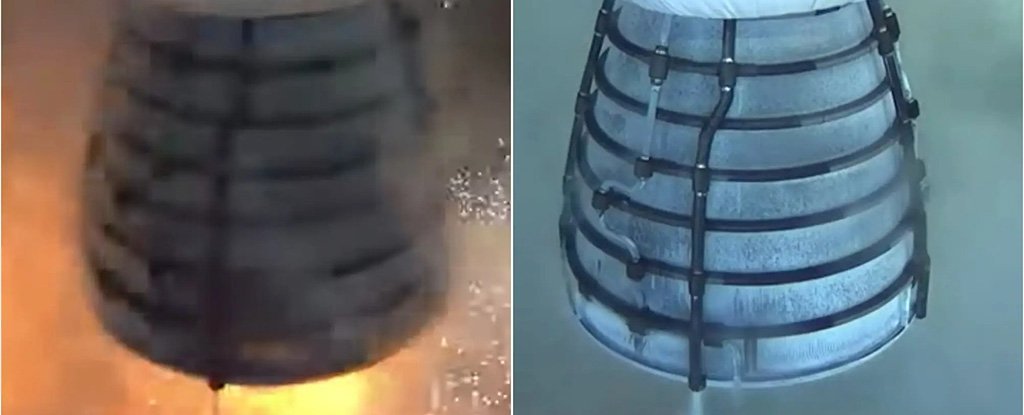NASA’s Massive Moon rocket ran into an engine problem during a critical test on Saturday, and the bug could delay the agency’s efforts Astronauts return to the moon.
The rocket, called the Space Launch System (SLS), is designed to finally stand at an altitude of 365 feet (111 meters) and carry astronauts to the moon sometime in the mid to late 2020s.
The system is an essential part of a larger program called Artemis, an estimated $ 30 billion effort to bring back shoes on the surface of the Moon for the first time since 1972. NASA has spent about $ 18 billion developing the rocket.
The SLS core stage – the largest piece in the system and its structural backbone – was assembled and tied tightly at the Stennis Space Center in Bay St. Louis, Mississippi, on Saturday to conduct a “hot fire” test.
For the first time, the missile was simultaneously ready for launch Four powerful RS-25 engines As it is at launch.
According to NASA, the base stage is the largest and most powerful rocket stage in the world. It hosts five major divisions, including a 537,000 gallon (2 million L) tank for liquid hydrogen, a 196,000 gallon (742,000 L) tank for liquid oxygen, four RS-25 engines, electronic computers, and other subsystems.
Boeing is the lead contractor for the stage, and Aerojet Rocketdyne is responsible for the RS-25 engines, which are used to help propel NASA’s fleet of space shuttles.
The fuel tanks filled up with 733,000 gallons of cryogenic propellant on Saturday, and the engines came back to life around 5:27 PM EST.
“It was almost like an earthquake,” NASA Administrator Jim Bridenstein told reporters at a news conference after the test.
“It was a wonderful moment. It brought joy because after all this time, we now have a missile. The only missile on the face of the planet that can take humans to the moon is launching all four RS-25 engines at the same time.”
The engines were supposed to run continuously for eight minutes. But after one minute of testing, the ECM sent a command to the primary phase controller to shut down.

Observers saw a flash next to the thermal protection blanket covering the fourth engine. Shortly thereafter, this drive recorded the MCF, or “major component failure”. It is not clear what happened.
“At the time they made the call, we still had four good engines operating at 109 percent,” John Honeycutt, SLS program manager at NASA’s Marshall Space Flight Center, said at the press conference.
Everything captured on a NASA Live broadcast:
“The amount of progress we have made here today is amazing. No, this is not a failure. This is a test. And we tested today in a meaningful way, where we will learn as we are,” Bridenstein said: “We are making adjustments and we will fly to the moon.”
The SLS team will spend the next few days sifting through the data from the test, assessing the base stage and drivers to see what happened and how to proceed.
NASA may need to re-run the hot fire test
Saturday’s hot fire was supposed to be the eighth and final step in NASA’s “Green Run” program, a program designed to thoroughly test every part of the base stage before launching the first SLS, called Artemis 1 – an unmanned test flight currently scheduled for November. 2021.
But this timeline may be unrealistic now. If the hot flames went well, NASA was planning to ship the rocket to the Kennedy Space Center in Cape Canaveral, Florida in February. There, workers stack all parts of the boosters needed to send Artemis 1 around the moon.
It is unclear how long it will take NASA to correct the engine fault and reach the base stage of Florida now.
“It depends on what this anomaly is and how difficult it is to fix it,” Bridenstein said. “And we have a lot to learn to find out.”
“It is very good that it is something that can be easily fixed and we can feel confident getting down to the head and sticking to the schedule. It is also true that we may find a challenge that will take more time.”
The agency may have to retest the hot fire. The SLS team wanted at least 250 seconds of firing the engines together to get high confidence in the car. The Sabbath test lasted just over 60 seconds.
It will take at least four or five days to prepare the Stennis Space Center facilities for another test. If NASA needed to replace existing engines with new ones, workers could do so on site at the Stennis Space Center. Honeycutt estimated it would take about seven to 10 days to do this.
“That’s the reason we tested,” Bridenstein said. “Before we put American astronauts on American missiles, then we need them to be perfect.”
This article was originally published by Interested in the business.
More from Business Insider:

“Appassionato di alcol. Piantagrane. Introverso. Studente. Amante dei social media. Ninja del web. Fan del bacon. Lettore”.

